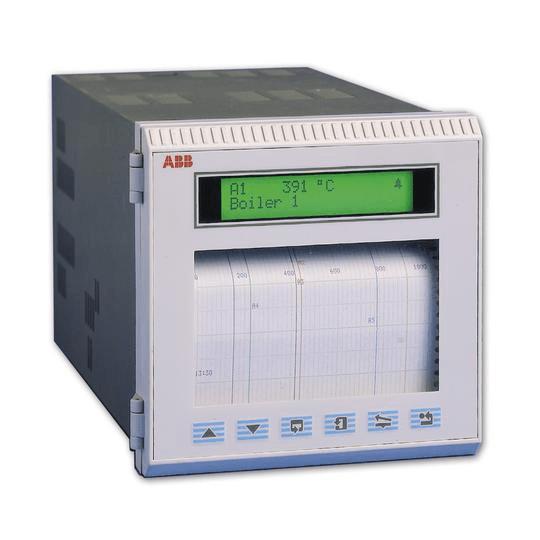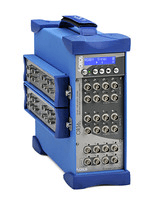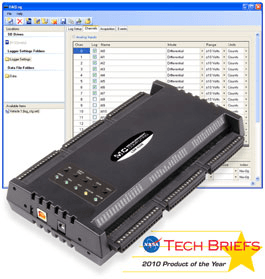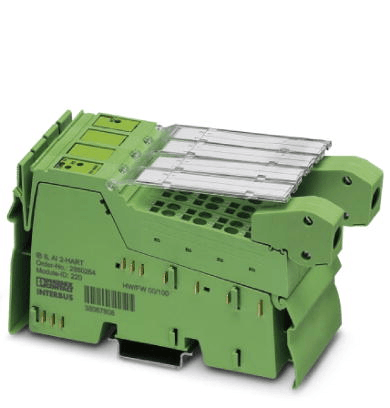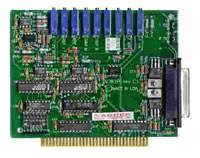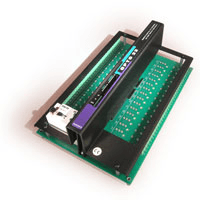Data Acquisition Information
Data acquisition, referenced by the acronyms DAS or DAQ, is the digitizing and processing of multiple sensor or signal inputs for the purpose of monitoring, analyzing, and/or controlling systems and processes. Signal or sensor inputs define the behavior of physical parameters and come from devices such as sensors, timers, relays, and solid-state circuits. Internal circuitry is used to digitize and process these input in order to monitor, analyze and/or control systems and processes.
Types of Data Acquisition Equipment
Data acquisition is a broad area that encompasses several specific products. Products represented below include computer boards, instruments or systems, data loggers or recorders, chart recorders, input modules, output modules, and I/O modules.
| Chart recorders and strip charts are data acquisition tools used to generate a plot, graph or other visualization of data versus time. Each device is configured to produce one of several different types of charts including circular charts, strip charts, X-Y plotter charts, and paperless or video graphs. |
Image Credit: ABB Measurement Products |
| Data acquisition computer boards are self-contained printed circuit boards (PCBs) that plug into backplanes and motherboards, or interface directly with computer buses. They receive multiple electrical or electronic inputs from devices such as sensors and translate analog data into a digital format that computers can process. | 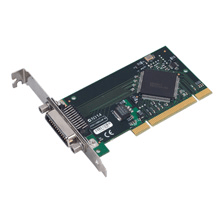
Image Credit: ADVANTECH |
| Data acquisition systems and instruments are configured in a wide variety of instrumentation and modular systems. They are generally packaged in an enclosure or chassis with a user interface and display. They collect, digitize, and process multiple sensor or signal inputs for the purpose of monitoring, analyzing, and/or controlling systems and processes. |
Image Credit: OROS |
| Data loggers and data recorders acquire digital data from sensors and other signals. They are primarily used to store data for subsequent downloads to a host PC, but may also include real-time features such as monitors and alarms. |
Image Credit: Measurement Computing |
| Data input modules receive signals from devices such as sensors and often provide voltage and current excitation along with signal conditioning. They are a front end device that interfaces with computer boards, systems, instruments, or recorders. |
Image Credit: PHOENIX CONTACT |
| Dat a output modules transfer amplified, conditioned, or digitized signals to processing systems or devices. They are a backend device and the signal is a conditioned output from a computer board, system, instrument, or recorder. |
Image Credit: ACCES I/O Products, Inc. |
| Data acquisition I/O devices have both input and output functionality. Digital or discrete I/O modules include on-off signals used in communication, user interface, or control. |
Image Credit: OPTO 22 |
Signal Conditioning
Signal conditioners provide filtering, amplification, converting, and / or other processes required to make sensor outputs suitable for data acquisition. The signal conditioning process is also known as a transfer function because the final effect is to convert an input signal (or measurement) into a suitable output signal. For instance, when a temperature sensor measures the temperature of a system or environment, the output of the sensor (temperature) is not suitable to be an input signal to an electrical system. Therefore, the temperature measurement must be converted into an electrical signal.
The following diagram shows the evolution of a signal from the sensor through the central processing unit and to the output or load. More detailed information is available in Engineering 360's Signal Conditioners Selection Guide.

The signal chain. Image Credit: Electronic Design
The conditioning of the signal can be handled by a signal conditioner, signal converter, or may be integrated within the module that receives the inputs or the device that takes the measurement. The amount of conditioning required is dependent on the carrier signal and transmission distance. A transmitter with an analog current output is generally required when transmitting a signal over extended distances.
Interfacing
An interface is used to transfer conditioned and digitized signal and sensor data to and from a system. Data acquisition products interface via a wide variety of field buses, computer buses, and other protocols. They may have a direct backplane interface, dock in modular bay or slot, or have a dedicated Ethernet, serial, parallel, wireless, or other port type used for interfacing with a host computer.
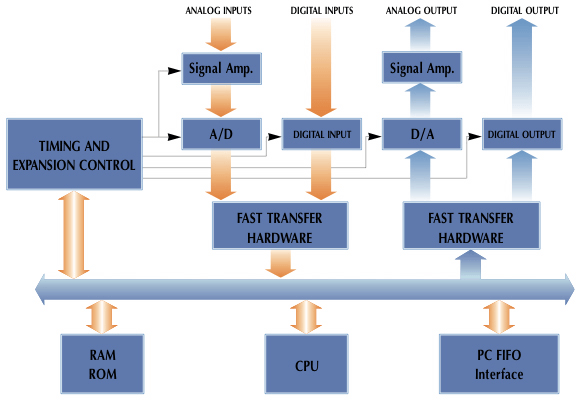
Image Credit: HUNG TA INSTRUMENT CO., LTD.
Device Function
The function of the device is to monitor, analyze or control systems and processes.
Monitor
Data acquisition devices used to monitor process and systems have the ability to record data points over a timed interval. They are customized for a particular application and may require specific modules in order to accommodate the type or number of inputs used. They may be equipped with on-board memory, removable storage, or may interface with a computer, used to process, store, and visualize the data. They may also be equipped with a switched output used to trigger an alarm or activate a switch when a pre-set condition is met or exceeded.
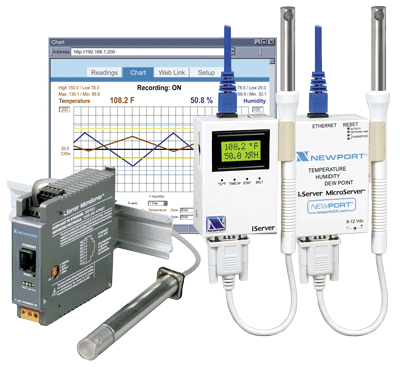
Monitoring with a virtual chart recorder. Image Credit: Newport Electronics, Inc.
Analyze
Data acquisition hardware may be used for data analysis. Data points or real-time data can be fed into a system that reduces or compiles data in order to generate useful information. Fourier transforms are used to reduce a signal with respect to time into a series of sinusoidal terms. Application software is commonly used for signal processing and measurement functions.
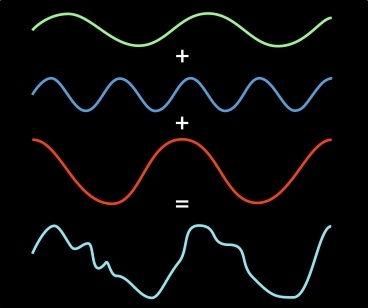
Fast fourier transforms (FFT). Image Credit: The Register
Control
Data acquisition products can be used to control processes and systems. The central processing unit receives a feedback signal and produces a switched output or analog control signal that is used to control devices in a system or process. Common applications include motion control, industrial automation, web processing, and other industrial operations. Supervisory control and data acquisition (SCADA) systems are large-scale, industrial control and measurement systems that consist of a central host, one or more remote units, a communications network, and specialized software. More detailed information about SCADA is available in Engineering 360's Supervisory Control and Data Acquisition Systems (SCADA) Selection Guide.
Form Factor
Common form factors for data acquisition products include circuit board, panel or chassis mount, modular bay or slot system, rack mount, DIN rail, and stand-alone.
- Printed circuit boards (PCBs) attach to enclosures or plug into computer backplanes.
- Panel or chassis mounts are used to install the device in cabinets, enclosures, or panels with bolts.
- Modular style units include stackable units that dock in bays, slots, or boxes.
- Rack units that fit inside a standard 19” telecommunications rack.
- Devices can be designed for mount on a Standard Deutsches Institute for Normung (DIN) rail, which is a German standard.
- Benchtop or freestanding devices often feature full casings or cabinets and integral interfaces.
Device Specifications
Device specifications that are important to consider when searching for data acquisition products include analog input channels, digital I/O channels, and accuracy.
Analog signals are a wave signal which means that the value changes steadily over time and can have any value in a range. Products with analog inputs can have multiple channels. Channels are either single-end or differential.
Single-end inputs have only one low wire shared by all inputs. For example, a board could have 2 single-end inputs; there will be two input lines and one ground line. Single-end inputs are less expensive and allow for twice the number of inputs in the same size wiring connector since they only require one analog input and one ground input which is shared by all the inputs. They save space and are easier to install. When single-ended outputs are available, suppliers often specify the maximum number of analog channel outputs as twice the number of differential outputs.
Differential channels have two inputs. The voltage is the signal processed between the two inputs. The board will have one signal and one ground pin for each input to allow for measurement voltage difference between two signals tied to the same ground. Differential channels provide excellent common-mode noise rejection. This type of input should be used when EMI, RIF or noise is present.
Digital signals do not have 'in between' values. They are an on or off signal producing a square wave. Digital signals break down the information into binary code, which is a series of 1s and 0s. The data receiver reassembles the code into useful information. Digital signal allows users to send more information in a smaller space.
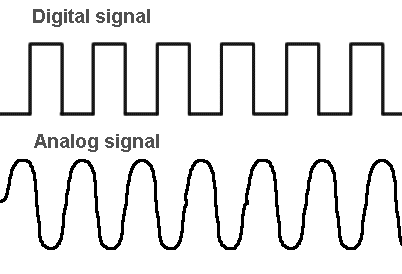
Image Credit: Being Ministry
Accuracy is defined as the difference (error) between the true value and the indication expressed as percent of the span. Accuracy, which is represented as a percentage of a full-scale measurement range, depends on signal conditioning linearity, hysteresis, and temperature considerations. It includes the combined effects of method, observer, apparatus and environment.
Static accuracy is the combined effects of linearity, hysteresis, and repeatability. It is expressed as +/- percentage of full scale output. The static error band is a good measure of the accuracy that can be expected at constant temperature.
Linearity is the deviation of a calibration curve from a specified straight line. One way to measure linearity is to use the least squares method, which gives a best fit straight line. The best straight line (BSL) is a line between two parallel lines that encloses all output vs. pressure values on the calibration curve.
Repeatability is the ability of a transducer to reproduce output readings when the same pressure is applied to the transducer repeatedly, under the same conditions, and in the same direction.
Hysteresis is the maximum difference in output at any pressure within the specified range, when the value is first approached with increasing and then with decreasing pressure. Temperatures hysteresis is the sensor's ability to give the same output at a given temperature before and after a temperature cycle.

Image Credit: Wikimedia
Signal Inputs
Data acquisition products may be designed to interface with specific types of inputs or may interface with modules that can accommodate a wide variety of inputs. Common input signals that interface with data acquisition products include:
- DC type voltage and/or current
- AC type voltage and/or current
- Frequency waveforms for varying frequency, pulse or specialized waveforms.
- Charge which comes from a piezoelectric device and usually requires conditioning.
Sensor Inputs
Sensor inputs can be an accelerometer, thermocouple, thermistor, RTD, strain gauge or bridge, and LVDT or RVDT. Specialized inputs include encoders, counters or tachometers, timers or clocks, relays or switches, and other specialized inputs.
Excitation
Sensors can be classified as either active or passive devices. Passive devices, like thermocouples, can generate a signal without a power supply. Active sensors need a power supply in order to control the flow of electrons and make a measurement. In some cases active sensors are powered by the signal conditioner. The output from the signal conditioner that powers the device is referred to as an excitation source. Signal excitation can either be a voltage or current output. The following schematic showcases how an excitation voltage powers a Wheatstone bridge:
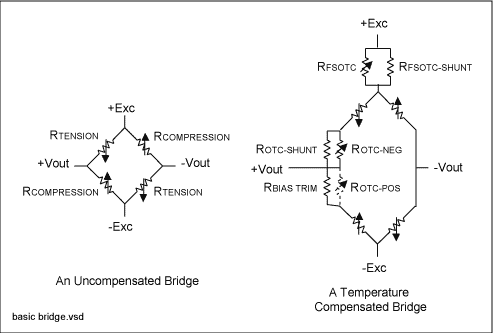
Image Credit: Maxim
Outputs
Outputs for data acquisition products can be voltage, current, frequency, timer or counter, relay, resistance or potentiometer, and other specialized outputs.
User Interface
Several user interfaces are available that allow the user to make adjustments to the system.
- A front panel is a local interface with integral controls, a keypad, and/or display on the panel of the unit
- Computer programmable converters are interfaced with a separate supervisory or host computer.
- Touch screens have a visual display which interacts with the user through touch. The user can directly put in information through the contact-sensitive screen.
- Remote and handheld devices can be mobile while the user enters program parameters.
- Devices with no user interface for input or programming are used for storage. The downloading and processing is done in another location.
Resources
Interfacebus.com - Electronic Engineering Dictionary
Electronics-Tutorials.WS - Basic Electronics Tutorials
National Instruments - Monitoring Applications with Data Acquisition Hardware
DATAQ INSTRUMENTS - Waveform Analysis Using The Fourier Transform
- Alabama
- Arizona
- California
- Colorado
- Connecticut
- Florida
- Georgia
- Iowa
- Illinois
- Indiana
- Kansas
- Kentucky
- Louisiana
- Massachusetts
- Maryland
- Maine
- Michigan
- Minnesota
- Missouri
- Montana
- North Carolina
- Nebraska
- New Hampshire
- New Jersey
- New Mexico
- Nevada
- New York
- Ohio
- Oklahoma
- Oregon
- Pennsylvania
- Rhode Island
- South Carolina
- Tennessee
- Texas
- Utah
- Virginia
- Vermont
- Washington
- Wisconsin
- West Virginia
- AC Current Input
- AC Voltage Input
- Accelerometer Input
- Aerospace / Military
- All Pass
- Anti-aliasing Filter
- Application Software Included
- Band Pass
- Band Stop
- CANbus
- Channel-to-Channel Isolation
- Charge Input
- Chart Recorder
- Computer Programmable
- Counter / Tachometer Input
- Current Excitation Supply
- Current Output
- DC Current Input
- DC Voltage Input
- DIN Rail
- Data Acquisition Computer Board
- Data Acquisition Instrument / System
- Datalogger / Recorder
- DeviceNet
- Differential Channels
- Direct Backplane Interface
- Encoder Input
- Environmental
- Ethernet
- Ethernet
- Foundation Fieldbus
- Frequency Input
- Frequency Output
- Front Panel and Display
- General Lab and Industrial
- Gigabit Ethernet
- Hand-held / Remote Programmer
- High Pass
- I/O Module
- IEEE 1394 (FireWire®)
- IEEE 1394 (FireWire®)
- Input Module
- Integral Amplifier
- Integral Filter
- Isolated Analog Voltage Input
- Isolated Analog Voltage Output
- Isolated Digital Input
- Isolated Digital Output
- LVDT / RVDT Input
- Low Pass
- Marine
- Medical / Biomedical
- Modem
- Modular Bay / Slot System
- Networkable System
- User Interface: None
- Output Module
- PROFIBUS
- Panel / Chassis Mount
- Parallel Interface
- Printed Circuit Board (PCB)
- Programmable Filter
- Programmable Gain
- RS232/422/485
- RTD Input
- Rack Mount
- Radio / Telemetry
- Relay / Switch Input
- Relay Output
- SCSI
- Seismic / Geotechnical
- Stand Alone
- Strain Gauge / Bridge Input
- TTL
- Thermistor Input
- Thermocouple Input
- Timer / Clock Input
- Timer / Counter Output
- Touch Screen
- USB
- Vehicular
- Voltage Excitation Supply
- Voltage Output
- Weather / Meteorology
- Web Enabled
- analog data acquisition
- temperature data logging
- adc RS232
- thermocouple data acquisition
- wireless data acquisition
- USB adc
- portable data acquisition
- bluetooth data acquisition
- compact flash data acquisition
- dyno data acquisition
- equipment data acquisition
- ethernet data acquisition
- high speed data acquisition
- I2C sensor
- instrument data acquisition
- serial data acquisition
- simultaneous data acquisition
- SSPC-AB 1
- strain gauge data acquisition
- thermal data acquisition
- USB data acquisition hardware
- waveform digitizer
- acoustic data acquisition
- data acquisition DAQ device
- data acquisition load cell
- pac data acquisition
- resistance data acquisition
- 4-20mA data acquisition
- data acquisition DAQ
- dynamometer data acquisition
